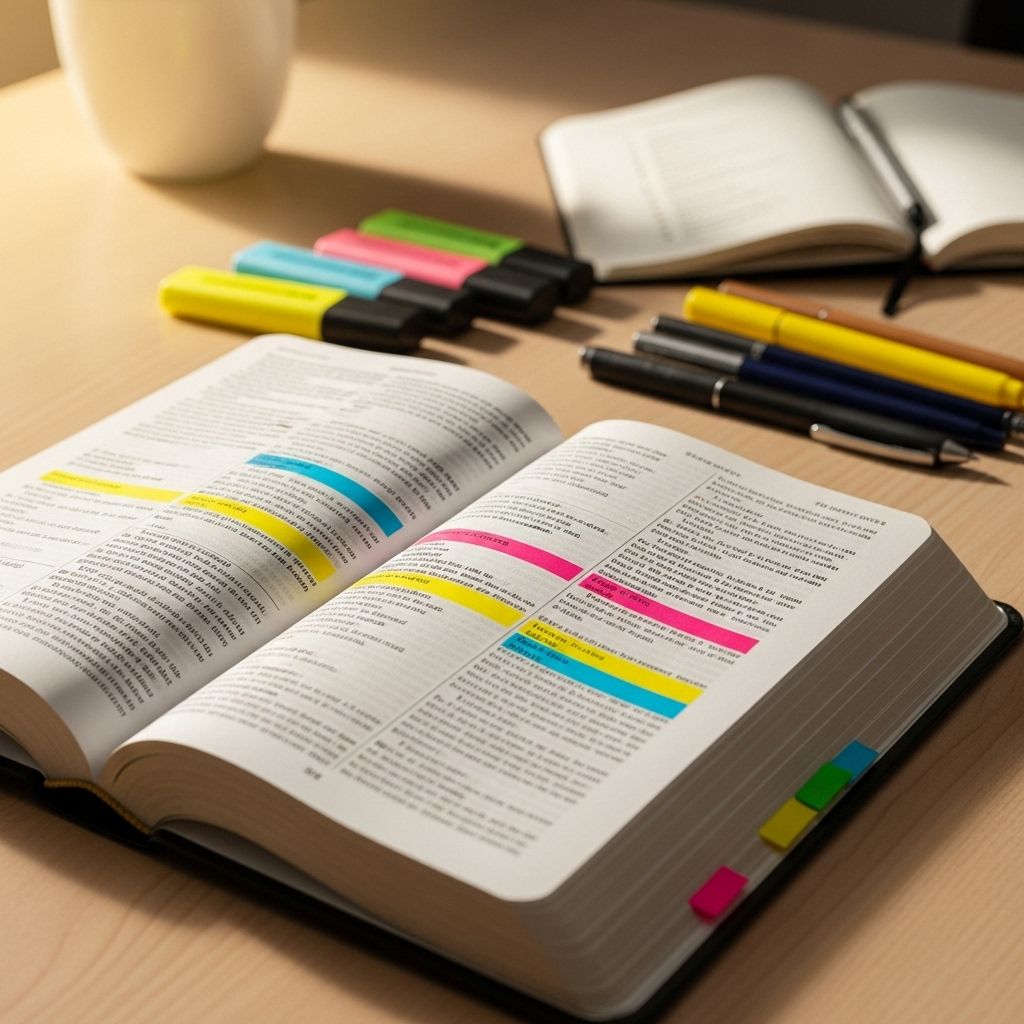Maximizing Bible Study with Highlighting & Color-Coding
Transform your personal Bible study through a practical, visually engaging color-coding and highlighting system designed to deepen understanding and spiritual reflection.

For many seeking a deeper connection with Scripture, simply reading the Bible can feel overwhelming. Words blur, themes become elusive, and lessons slip through the mind’s grasp. A practical and transformative solution is to integrate a highlighting and color-coding system into your Bible study. This visually engaging approach not only makes passages stand out, but also trains your heart and mind to meditate and absorb God’s Word more intentionally.
Why Use Color-Coding in Bible Study?
Highlighting and color-coding your Bible offers several powerful advantages that enrich both your study process and spiritual growth:
- Visual Clarity: Colors help key themes, instructions, and promises pop off the page, guiding your attention to the most significant truths.
- Helps Focus and Retention: The act of deciding which color to use encourages slow and thoughtful reading, leading to better memory and retention of Scripture.
- Deeper Understanding: Color-coding reveals patterns, connections, repeated words, and big ideas, unveiling the structure and intent of passages.
- Easy Review: Marked passages become simple to reference when you need encouragement or want to find a particular teaching.
- Application of Truth: Marking commands, promises, and truths with specific colors helps you see ways to apply Scripture to daily life.
- Personalized Study: A chosen color key reflects your spiritual journey and learning style, creating a unique, meaningful experience.
The Foundations of a Color-Coding System
The beauty of Bible color-coding is its flexibility. You can adapt systems to fit your needs, spiritual focus, and creativity. The following steps provide a guide for establishing your own system:
Step 1: Define Your Study Goals
Start by identifying what aspects of the Bible you most want to highlight or understand deeply. Are you focusing on God’s promises? The character of Jesus? Instructions for Christian living? Defining your goals clarifies which categories will make up your color key.
Step 2: Choose Your Categories
Based on your goals, select key themes or topics to assign to different colors. Common categories include:
- Attributes and works of God
- Teaching about Jesus (His life, words, work, promises)
- The Holy Spirit and spiritual gifts
- Commands and instructions
- Promises and blessings
- Sin and human failure
- Warnings or judgments
- Prayers and worship
- Faith, encouragement, and hope
- Personal application and areas for growth
Keep your system manageable. For most people, 6–8 categories are enough to cover the major biblical themes without overwhelming your palette.
Step 3: Select Your Colors
Pick distinct colors that are easy to differentiate, preferably ones that have an association with their category (e.g., green for growth or spiritual maturity, blue for promises like a vast sky). Avoid assigning similar shades for your most-used categories to prevent confusion during review.
Step 4: Create a Color Key Guide
Write out your chosen categories and corresponding colors on a bookmark, sticky note, or index card, and keep it inside your Bible. This reference sheet will help you stay consistent, especially as you begin or if you take breaks between study sessions.
Step 5: Commit to Consistency—But Allow Flexibility
Consistently apply your color assignments as you study, but don’t be afraid to adjust your system if a category isn’t working well or if you want to track a new spiritual theme. With experience, your approach may evolve.
Sample Bible Highlighting & Color-Coding System
Below is an example of a simple yet effective color-coding system. Use this as inspiration or adapt it to your own preferences:
| Color | Category | Purpose/Association |
|---|---|---|
| Purple | God’s Attributes & Works | Royalty, majesty, truths about God |
| Red | Jesus, Messianic Prophecy | Jesus’ words, actions, prophecies about Christ |
| Orange | Key Words & Repeated Phrases | Patterns, repetition, emphasis |
| Yellow | Spiritual Truths & Important Facts | Core doctrines, insightful statements |
| Blue | Commands to Obey | Instructions, imperatives, directives |
| Green | Application & Spiritual Growth | Personal insight, application, wisdom |
| Pink | Salvation, Eternal Life, Hope | Gospel, hope, encouragement, praise |
Tips for Getting Started
- Test your pens or highlighters on a blank Bible page to ensure they won’t bleed or smear.
- Begin with a single book (such as Psalms, John, or James) to develop your system before applying it throughout your Bible.
- Be patient—learning to distinguish categories will become more natural over time.
- If you’re not comfortable marking your main Bible, use a secondary copy or print passages for practice.
How Color-Coding Changes Your Bible Study
- Slows and Deepens Reading: As you decide how to mark each passage, you’ll pause and reflect—this repetition aids understanding.
- Encourages Cross-Reference: With clear markings, it’s easier to find related verses and develop deeper connections between Bible passages.
- Fosters Personal Application: Noting commands, encouragements, or convicting truths in specific colors helps you pray and apply Scripture personally.
- Builds a Spiritual Legacy: Your marked-up Bible becomes a testimony of your faith journey—encouraging for yourself and potentially meaningful for others in the future.
Common Questions About Highlighting & Color-Coding
Is it disrespectful to mark or highlight my Bible?
On the contrary, thoughtful highlighting can be an act of reverence, demonstrating your engagement and hunger for God’s Word. Many find it deepens their love and understanding of Scripture.
What if I change my mind about a color later?
Bible study is a dynamic process! If a category or color no longer fits, adjust your key. Use correction tape if needed, but don’t stress—your study system should serve you, not bind you.
Can I use other markings, like symbols or underlining?
Absolutely. You can combine highlighting with underlining, bracketing, or symbols (such as hearts for promises or stars for commands). Some prefer drawing small symbols in the margins to track themes.
How many colors is too many?
Too many colors can make your study confusing and cluttered. Focus on a handful of categories that matter most, and only expand as you become more comfortable.
Do I need expensive supplies?
Simple gel pens, colored pencils, or basic highlighters are sufficient. The value comes from your intentional reading—not the fanciness of your supplies.
Advanced Ideas for Personalizing Your Bible Color-Coding
- Add New Themes: As your study matures, add new colors for topics such as prophecies, fulfilled promises, or doctrines of the Holy Spirit.
- Track Prayer Needs: Consider adding a color for passages to pray, or jot prayer requests in the margins linked to highlighted commands or promises.
- Create a Yearly Theme: Use a specific color each year for verses God impresses on your heart, building a timeline of your growth.
- Mark Cross-References: Use small colored dots or letters to indicate related passages or themes across the Bible.
Example Color Key for Bible Study
| Color | Theme |
|---|---|
| Orange | Warnings, Sin, Enemy’s Work |
| Green | Wisdom, Life Application, Christian Living |
| Pink | Encouragement, Praise, Worship, Hope |
| Grey | Questions, Difficult Passages, To Study Further |
Integrating Color-Coding with Other Bible Study Methods
Combine highlighting with approaches such as the:
- Inductive Bible Study Method (observation, interpretation, application)
- SOAP Method (Scripture, Observation, Application, Prayer)
- Topical or word studies, using colors to flag recurring ideas
This synergy helps you dig below the surface and make deeper discoveries.
Frequently Asked Questions (FAQs)
Q: What do I do if I make a mistake while highlighting?
A: Don’t worry—no Bible study system is perfect. If possible, use correction tape or a white colored pencil to cover the error and mark over it again. Embrace small mistakes as part of your growth process.
Q: How do I stick with the system long-term?
A: Keep your color key accessible, start with manageable categories, and invite accountability by sharing your method with a friend or study group. Celebrate small wins as you see your understanding grow.
Q: Can color-coding benefit group Bible study?
A: Yes! Sharing your color system with others in a study group can stimulate conversation, highlight different perspectives, and make collaborative study more engaging and fruitful.
Q: How should I start if I feel intimidated?
A: Begin with one book and a few key categories. Recognize the purpose isn’t perfection, but connecting with God’s Word in a personal, meaningful way. With practice, the benefits will become clear.
Final Inspiration: Keeping the Focus on God
Ultimately, the goal of highlighting and color-coding isn’t a rainbow Bible—it’s transformation. Each time you pick up a pen or highlighter, invite the Holy Spirit to illuminate your heart and teach you. Let this system serve as a tool for worship, prayer, and lifelong growth as a follower of Christ. God promises that those who meditate on His law “day and night” will be “like a tree planted by streams of water” (Psalm 1:2–3)—rooted, fruitful, and abundant.
May your study be marked not just by colors, but by the light of Christ shining through you as you dwell deeply in His Word.
References
Read full bio of Sneha Tete











